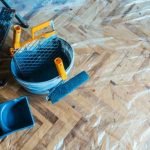Are you wondering how to claim home improvements on federal taxes? Understanding the basics of claiming home improvements is crucial for homeowners looking to maximize their tax benefits. From eligible expenses to keeping accurate records, there are several factors to consider when filing for tax deductions related to home improvement projects.
Eligible home improvement expenses can vary, and it’s important to know which specific upgrades and modifications qualify for a tax deduction. Whether it’s energy-efficient upgrades, medical equipment installations, or accessibility modifications for disabled individuals, understanding what expenses can be claimed is essential for homeowners.
Keeping detailed records of all home improvement expenses is crucial when filing for tax deductions. This includes invoices, receipts, contracts, and any other relevant documentation to support your claims. Proper record-keeping will help ensure that homeowners are prepared in the event of an IRS audit.
In this article, we will discuss the specifics of claiming home improvements on federal taxes and provide tips on how to navigate the process effectively. From understanding Form 5695 to the difference between tax credits and deductions, we will cover everything you need to know about maximizing your tax benefits from home improvements.
Eligible Home Improvement Expenses
When it comes to claiming home improvements on your federal taxes, there are specific expenses that are eligible for deductions. Knowing what qualifies for a tax deduction can help homeowners maximize their savings and ensure compliance with IRS regulations. Here are some eligible home improvement expenses that can be claimed on federal taxes:
- Energy-Efficient Upgrades: Any expenses related to making energy-efficient improvements to your home, such as installing solar panels, energy-efficient windows, doors, or insulation, may be eligible for tax credits. These upgrades not only benefit the environment but also provide financial incentives for homeowners.
- Medical Equipment Installations: If you have made modifications to your home to accommodate medical equipment for a qualified individual, such as installing ramps, handrails, or lifts, these expenses may be deductible on your federal taxes.
- Accessibility Modifications for Disabled Individuals: Expenses related to making your home more accessible and accommodating for disabled individuals, such as widening doorways, installing wheelchair ramps, or modifying bathrooms and kitchens, can also be claimed as deductions on federal taxes.
By keeping detailed records of all expenses related to these home improvements, including invoices and receipts from contractors or suppliers, homeowners can support their claims and ensure compliance with IRS guidelines.
Understanding how to claim home improvements on federal taxes is essential for homeowners who want to take advantage of potential tax savings while ensuring accurate reporting of eligible expenses. Consulting with a tax professional or accountant can provide valuable guidance in navigating the complex process of claiming home improvement deductions on federal taxes.
Keeping Records
Keeping accurate and detailed records of all home improvement expenses is crucial when it comes to claiming them on federal taxes. This includes invoices, receipts, and contracts, as these documents serve as evidence to support your tax claims. Without proper documentation, you may not be able to substantiate your expenses in the event of an IRS audit.
To ensure that you have all the necessary records for claiming home improvements on federal taxes, start by creating a dedicated folder or digital file to store all relevant documents. Make sure to include invoices from contractors or suppliers, receipts for materials purchased, and contracts outlining the scope of work and cost estimations. Organizing these documents chronologically can also make it easier to track your expenses over time.
In addition to collecting physical or digital copies of your home improvement records, it’s important to keep them in a safe and accessible place. Whether it’s a filing cabinet, cloud storage solution, or designated folder on your computer, having a centralized location for all your documents can simplify the process when it’s time to file your taxes. By being proactive about record-keeping, you can avoid potential headaches and delays in claiming home improvements on federal taxes.
| Tips | Benefits |
|---|---|
| Create a dedicated file or folder for storing all home improvement records. | Organizes documents chronologically for easy tracking. |
| Keep physical or digital copies of invoices, receipts, and contracts. | Serves as evidence for substantiating tax claims. |
| Store documents in a safe and accessible location such as a filing cabinet or secure cloud storage. | Simplifies the process when filing taxes and avoids potential delays. |
Form 5695
Filling out IRS Form 5695 is an important step in claiming residential energy-efficient property credits for eligible home improvements on federal taxes. This form allows homeowners to receive tax credits for making energy-efficient upgrades to their homes, which can ultimately result in significant savings. Here’s a step-by-step guide on how to fill out Form 5695:
Step 1: Provide Personal Information
The first section of Form 5695 asks for basic personal information, including your name, social security number, and address. It’s important to ensure that all information provided is accurate and up to date.
Step 2: Calculate Your Residential Energy Credits
The next part of the form requires you to calculate the amount of residential energy credits you are eligible for based on the energy-efficient improvements made to your home. This may include expenses related to solar panels, wind turbines, geothermal heat pumps, or other qualified energy-saving installations.
Step 3: Complete Part I or Part II as Applicable
Depending on the type of residential energy property installed in your home, you will need to complete either Part I or Part II of Form 5695. Part I is for residential energy-efficient property credit and Part II is for nonbusiness energy property credit.
By following these steps and filling out Form 5695 accurately, homeowners can claim valuable tax credits for their eligible home improvements. It’s also recommended that individuals consult with a tax professional or accountant if they have any questions or concerns about claiming home improvements on federal taxes.
Tax Credits vs Tax Deductions
When it comes to claiming home improvements on federal taxes, it’s important to understand the difference between tax credits and tax deductions. Both can provide financial benefits to homeowners, but they work in different ways.
Tax Credits
Tax credits directly reduce the amount of tax you owe, dollar for dollar. For example, if you are eligible for a $1,000 tax credit and you owe $2,000 in taxes, the credit will reduce your tax bill to $1,000. When it comes to home improvements, there are specific energy-efficient upgrades that may qualify for residential energy property credits. These can include solar panels, geothermal heat pumps, and small wind turbines.
Tax Deductions
On the other hand, tax deductions reduce your taxable income. This means that the deduction reduces the amount of your income that is subject to taxes. For home improvements, expenses such as medical equipment installations and accessibility modifications for disabled individuals may be eligible for deductions. It’s important to keep accurate records of all expenses related to these improvements in order to claim them on your taxes.
By understanding the difference between tax credits and tax deductions for home improvements, homeowners can ensure they are taking full advantage of potential savings when filing their federal taxes.
Given the complexity of tax laws and regulations surrounding home improvement deductions and credits, it is highly recommended that homeowners consult with a qualified tax professional or accountant who is knowledgeable about how to claim home improvements on federal taxes. They can provide guidance on eligibility requirements, documentation needed for claims, and any changes in tax laws that may impact the ability to claim certain home improvement expenses on federal taxes.
Home Office Deductions
When claiming home office improvements on federal taxes, it’s important to keep accurate records of all related expenses. This includes invoices, receipts, and contracts for any improvements made to the designated home office space. Examples of eligible expenses that can be claimed include renovations to the space such as adding walls or flooring, installing built-in shelving or storage, or making alterations to improve accessibility.
It’s crucial for homeowners looking to claim home office deductions on federal taxes to understand that personal use of the space disqualifies it from being eligible for the deduction. This means that if the designated home office space is used for any personal activities not related to conducting business (such as a playroom or guest bedroom), it cannot be claimed as a deductible expense.
Consulting with a tax professional or accountant can provide valuable guidance on understanding these requirements and ensuring compliant claims.
| Eligible Expenses | Requirements |
|---|---|
| Renovations (e.g. walls, flooring) | Space must be used regularly and exclusively for conducting business |
| Installing built-in shelving/storage | Must be principal place of business or used for meeting with clients/customers |
| Accessibility improvements | No personal use of space allowed |
Hiring a Professional
When it comes to claiming home improvements on federal taxes, seeking the advice of a tax professional or accountant can be incredibly beneficial. These individuals have the expertise and knowledge to navigate the complex tax laws and regulations surrounding home improvement deductions, ensuring that homeowners make accurate and compliant claims. Here are some reasons why hiring a professional is essential for claiming home improvements on federal taxes:
1. Expert Guidance: Tax professionals and accountants are well-versed in the ever-changing tax laws and regulations, especially those related to home improvement deductions. They can provide personalized advice based on an individual’s specific financial situation and home improvement expenses.
2. Maximizing Deductions: By working with a professional, homeowners can ensure that they are maximizing their deductions for eligible home improvement expenses. A tax expert can identify all applicable deductions, credits, and incentives available for different types of home improvements, helping homeowners to maximize their tax savings.
3. Compliance and Accuracy: One of the most significant benefits of consulting with a tax professional or accountant is ensuring that all claims are made accurately and comply with IRS regulations. These professionals can help homeowners keep detailed records of their home improvement expenses and complete the necessary forms correctly to avoid potential audits or penalties.
Hiring a tax professional or accountant when claiming home improvements on federal taxes is crucial for ensuring accuracy, maximizing deductions, and staying compliant with IRS regulations. With their expertise and guidance, homeowners can navigate the complexities of home improvement deductions with confidence, ultimately saving them time and money in the long run.
IRS Resources
In conclusion, claiming home improvements on federal taxes can be a valuable way for homeowners to recoup some of the expenses incurred in making their homes more energy-efficient, accessible, or accommodating for medical needs. Understanding the basics of home improvement tax deductions is essential for ensuring that eligible expenses are properly documented and claimed.
From energy-efficient upgrades to medical equipment installations and accessibility modifications for disabled individuals, there are various eligible home improvement expenses that can be claimed on federal taxes.
Keeping accurate and detailed records of all home improvement expenses is crucial for substantiating tax claims. This includes invoices, receipts, and contracts related to the improvements made. Additionally, homeowners should familiarize themselves with IRS Form 5695, which is used to claim residential energy-efficient property credits for eligible home improvements. The difference between tax credits and tax deductions for home improvements should also be understood, as well as how each one can benefit homeowners.
Moreover, it is important to consider seeking professional guidance from a tax professional or accountant when claiming home improvements on federal taxes. They can provide valuable expertise and ensure that claims are accurate and compliant with IRS regulations. Ultimately, by taking advantage of available IRS resources and understanding the specific requirements for claiming home office deductions or energy-efficient property credits, homeowners can maximize their potential tax benefits from eligible home improvement expenses.
Frequently Asked Questions
What Does the IRS Consider Capital Improvements on Home?
The IRS considers capital improvements on a home as any upgrades or additions that increase the home’s value, prolong its useful life, or adapt it to new uses. This includes things like adding a room, remodeling the kitchen, or installing a new heating system.
Are Home Office Renovations Tax Deductible?
Generally, home office renovations are not fully tax deductible. However, if the renovations are directly related to the functionality of your home office and not for personal use, you may be able to deduct a portion of the expenses as a business expense on your taxes.
Is Homeowners Insurance Tax Deductible?
Homeowners insurance is generally not tax deductible for personal residences unless part of the home is used for business purposes. In this case, you may be able to deduct a portion of your homeowners insurance as a business expense related to operating out of your home.

I’m thrilled to have you here as a part of the Remodeling Top community. This is where my journey as an architect and remodeling enthusiast intersects with your passion for transforming houses into dream homes.





